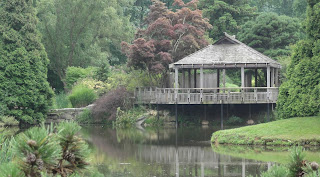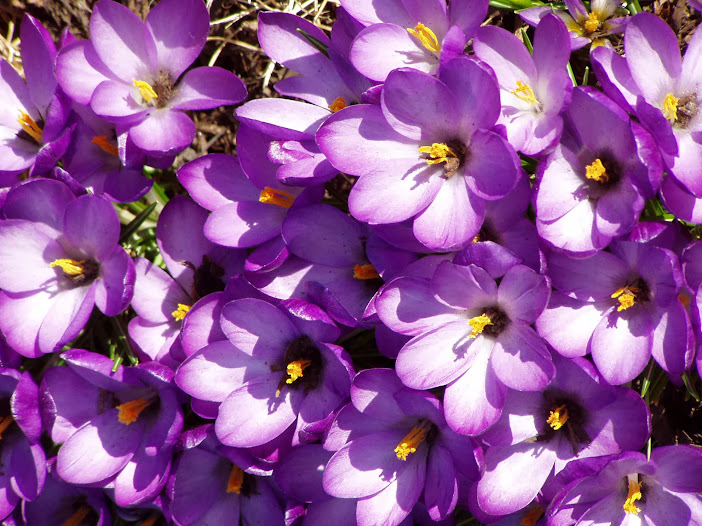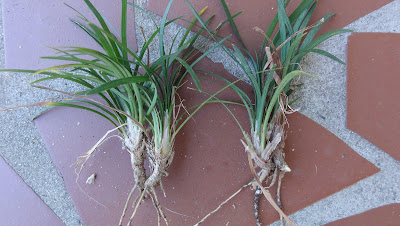Spring cinquefoil (pronounced "sink-foil", or "sank-foil" if you prefer French), might be barely noticed if not in bloom and trodden underfoot. Its relative, the rose, has inspired volumes of poetry. But, so far as I know, cinquefoil has inspired only two poems and one piece of music.
One poem is Mysteries by Jack Sanders in which he wondered:
The bigger question does remain:
How you pronounce that funny name?
Does it ‘sink’ or does it ‘sank’
As it wanders up the bank?
The other is The Cinquefoil (An Impotent Rose), a parody of Edna Saint Vincent Millay by Sinfull, nom de plume of Terri Turrell.
The music is Little Flowers Op.205 No.5 Cinquefoil by Cornelius Gurlitt (1820-1901). Perhaps you remember it from your days as a young piano student.
There are over 300 species of cinquefoil. My subject is Potentilla neumanniana 'Nana', also known as Potentilla tabernaemontani, Potentilla verna or Potentilla crantzii.
Potentilla was named by Heinrich Gottlieb Ludwig Reichenbach (January 8, 1793 - March 17, 1879), a German botanist and ornithologist. Potentilla refers to powerful medicinal properties possessed by members of the genus, as noted in Sauer's Herbal and Rodale's Illustrated Encyclopedia of Herbs. Neumanniana was given probably to honor either Henri François Joseph Neumann (1899-1858), or Louis Neumann (1827-1903). Both were botanists and horticulturists at the Jardin des Plantes in Paris. I'm guessing the elder was honored. 'Nana' differentiates the dwarf form from the common species.
Spring cinquefoil is native to North America and Greenland, known to thrive from the northernmost regions of eastern Canada to Massachusetts and Connecticut. It is reliably hardy to USDA climate zone 8, yet it has been successfully grown as far south as zone 10.
Upon seeing it for the first time, you might mistake it for Appalachian Barren Strawberry (Waldsteinia fragaroides), or another of the Waldsteinia species. They have strawberry-like leaves and yellow flowers. To add to the confusion, spring cinquefoil is also commonly called "barren strawberry." But Walsteinias are identified by three leaflets. Potentillas have five, thus the name "cinquefoil."
Dwarf spring cinquefoil grows about 6 inches high and spreads to 12 inches. Fragrant foliage is evergreen. Loads of bright yellow flowers appear in spring, making quite a show.
Plant it in average, well-drained loamy soil with pH ranging from 6.1 to 7.8. The site should be exposed to full sun or partial shade. Space young plants 12 inches to 15 inches apart. Take care not to overwater.
Dwarf spring cinquefoil is a marvelous ground cover for alpine and rock gardens, especially in bulb gardens where you need something to hide old bulb foliage and crowns. Grow it in container gardens as an underplanting. Tuck cinquefoil in stone walls and between stepping stones.
Potentilla neumanniana 'Nana' spreads readily, making a fine lawn grass substitute, even in areas that receive a little foot traffic. You can trim spring cinquefoil with your lawn mower. Set your mower at a high position.
Need something to plant on that slope? No matter how you pronounce it, you'll love your spring cinquefoil as it wanders up the bank.
Return to GoGardenNow.com.
 |
| Potentilla neumanniana 'Nana' - Spring cinquefoil |
One poem is Mysteries by Jack Sanders in which he wondered:
The bigger question does remain:
How you pronounce that funny name?
Does it ‘sink’ or does it ‘sank’
As it wanders up the bank?
The other is The Cinquefoil (An Impotent Rose), a parody of Edna Saint Vincent Millay by Sinfull, nom de plume of Terri Turrell.
The music is Little Flowers Op.205 No.5 Cinquefoil by Cornelius Gurlitt (1820-1901). Perhaps you remember it from your days as a young piano student.
There are over 300 species of cinquefoil. My subject is Potentilla neumanniana 'Nana', also known as Potentilla tabernaemontani, Potentilla verna or Potentilla crantzii.
Potentilla was named by Heinrich Gottlieb Ludwig Reichenbach (January 8, 1793 - March 17, 1879), a German botanist and ornithologist. Potentilla refers to powerful medicinal properties possessed by members of the genus, as noted in Sauer's Herbal and Rodale's Illustrated Encyclopedia of Herbs. Neumanniana was given probably to honor either Henri François Joseph Neumann (1899-1858), or Louis Neumann (1827-1903). Both were botanists and horticulturists at the Jardin des Plantes in Paris. I'm guessing the elder was honored. 'Nana' differentiates the dwarf form from the common species.
Spring cinquefoil is native to North America and Greenland, known to thrive from the northernmost regions of eastern Canada to Massachusetts and Connecticut. It is reliably hardy to USDA climate zone 8, yet it has been successfully grown as far south as zone 10.
Upon seeing it for the first time, you might mistake it for Appalachian Barren Strawberry (Waldsteinia fragaroides), or another of the Waldsteinia species. They have strawberry-like leaves and yellow flowers. To add to the confusion, spring cinquefoil is also commonly called "barren strawberry." But Walsteinias are identified by three leaflets. Potentillas have five, thus the name "cinquefoil."
Dwarf spring cinquefoil grows about 6 inches high and spreads to 12 inches. Fragrant foliage is evergreen. Loads of bright yellow flowers appear in spring, making quite a show.
Plant it in average, well-drained loamy soil with pH ranging from 6.1 to 7.8. The site should be exposed to full sun or partial shade. Space young plants 12 inches to 15 inches apart. Take care not to overwater.
Dwarf spring cinquefoil is a marvelous ground cover for alpine and rock gardens, especially in bulb gardens where you need something to hide old bulb foliage and crowns. Grow it in container gardens as an underplanting. Tuck cinquefoil in stone walls and between stepping stones.
Potentilla neumanniana 'Nana' spreads readily, making a fine lawn grass substitute, even in areas that receive a little foot traffic. You can trim spring cinquefoil with your lawn mower. Set your mower at a high position.
Need something to plant on that slope? No matter how you pronounce it, you'll love your spring cinquefoil as it wanders up the bank.
Return to GoGardenNow.com.























